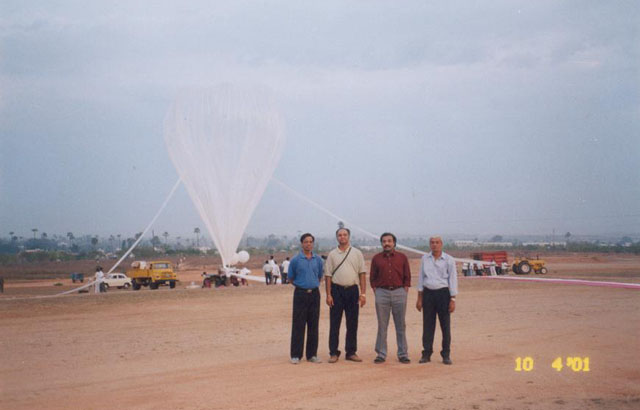Purpose of the flight and payload description
This balloon experiment was conducted to study the characteristics of aerosols over a tropical station in India and to examine long-term changes (if any) in the upper troposphere and stratosphere during volcanically quiescent conditions.
The payload was composed by two multichannel photometer systems, coupled to a sun-scanning and a sun-tracking system. It measured the direct as well as the angular distribution of the scattered radiation intensities. The sun-scanning instrument consists of a sensor assembly containing six ?lter photometers, the sun-tracking mechanism, and a motor assembly for scanning the sky along the solar almucantar, ±90º with respect to the sun for scattered sky radiation measurements. The sun-tracking photometer, an automatic axis stabilised system was employed to measure altitude pro?les of the direct solar radiation intensities uninterruptedly. The wavelengths used in the sun-tracking system are 290, 430, 500, 850, 950 and 1050 nm, with similar bandwidths.
The balloon was launched at around 6.26 local time and reached the expected ceiling altitude of about 33.5 km by around 9.00 h. After about an hour of ?oat duration, the balloon was brought down to about 20 km in about 2 hours by releasing the gas through an apex valve incorporated in the balloon. The ?ight was terminated around 13.00 h and the instruments were released on a parachute and recovered. Data were collected during both ascent and descent.
Details of the balloon flight
Balloon launched on: 4/10/2001 at 6:26 IST
Launch site: TIFR National Balloon Facility, Hyderabad, India
Balloon launched by: National Balloon Facility, Tata Institute of Fundamental Research
Balloon manufacturer/size/composition: Zero Pressure Balloon 53.900 m3 (Antrix 0.25 mil)
Flight identification number: 450
End of flight (L for landing time, W for last contact, otherwise termination time): 4/10/2001 at ~ 13:00 IST
Balloon flight duration (F: time at float only, otherwise total flight time in d:days / h:hours or m:minutes - ): 6 h
Payload weight: 304 kgs
Overall weight: 538 kg
External references
- Balloon-borne study of the upper tropospheric and stratospheric aerosols over a tropical station in India Tellus (2003), 55B, 820-836
- Registros de lanzamiento de TIFR TIFR's balloon launch records
- Scientific ballooning in India - Recent developments Advances in Space Research, Volume 37, Issue 11, p. 2015
1091If you consider this website interesting or useful, you can help me to keep it up and running with a small donation to cover the operational costs. Just the equivalent of the price of a cup of coffee helps a lot.


